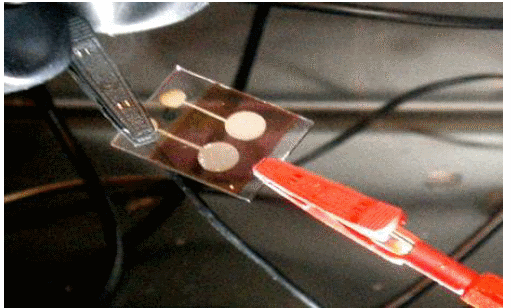17 JUNE 2013
What is the simplest molecule capable of transforming solar energy into electricity? A team from the Institut des Sciences et Technologies Moléculaires d'Angers (Moltech-Anjou, CNRS/Université d’Angers) found the answer. The researchers demonstrated that extremely simple molecules, produced in few steps with very good synthesis yields, could become credible alternatives to the more complex molecules and polymers currently used to produce organic solar cells. Their work, published online in Advanced Functional Materials and Chemistry: A European Journal, has made it possible to obtain molecules of low molecular weight with an electrical conversion efficiency above 4 %. In this way, they have shown that by optimizing simple molecules, it should be possible to go from fundamental research to the industrial production of solar devices manufactured from organic molecules.
Since the start of the millennium, there has been intense international competition to produce solar cells from organic molecules with performance levels similar to those of the silicon cells currently used in commercially available solar panels. In fact, organic photovoltaic cells should be cheaper to produce and could moreover lead to new applications.
Two approaches are currently under study in organic photovoltaics: the most widespread is based on the use of polymers. However, these materials are composed of macromolecular chains of different lengths, which can cause problems of reproducibility of their electronic properties. The other approach, first developed by the same team at the Institut Moltech-Anjou in 2005—and taken up since by many other laboratories, consists in using soluble organic molecules with a perfectly defined structure. This strategy has recently made it possible to obtain electrical conversion efficiencies of more than 7 %, similar to those of polymer-based cells (8-9 %).
However, these relatively complex molecules are difficult to produce. The most efficient require twelve synthesis steps, with an overall yield of less than 0.10 %, which is hardly compatible with industrial-scale production! For this reason, the researchers from the Institut Moltech-Anjou decided to integrate constraints specific to the photovoltaics industry in the conception of new molecules, in terms of synthesis yield, cost and environmental impact.
The first step in their approach consisted in trying to discover the simplest molecules that exhibit an interesting photovoltaic effect. They thus decided to work on a family of molecules based on triarylamines, which can be synthesized in few steps. They then sought to optimize certain properties of these molecules, namely their light absorption capacity, energy levels, stability and electrical charge mobility. They then carried out molecular engineering work on these minimalist structures by adding, as necessary, certain types of bonds or chemical groups.
In this way, they were able to develop molecules of low molecular weight with an electrical conversion efficiency of around 4 %, which is one of the highest efficiencies obtained with molecules of such simple structure. These molecules can be synthesized with excellent yields. This research, which benefits from the support of industrial groups, is being continued in order to improve both the methods of synthesis and the performance of photovoltaic cells. One of the objectives is to reduce the use of toxic reagents and solvents and expensive catalysts so that these molecules can be integrated into photovoltaic devices that can be mass-produced.
Bibliography
Small D-π-A systems with o-phenylene-bridged accepting units as active material for organic photovoltaics
Antoine Leliège, Jérémie Grolleau, Magali Allain, Philippe Blanchard, Dora Demeter, Théodulf Rousseau, and Jean Roncali
Chemistry: A European Journal, published on-line on the 17 June 2013.
http://onlinelibrary.wiley.com/doi/10.1002/chem.201301054/abstract
Tuning of the Photovoltaic Parameters of Molecular Donors by Covalent Bridging
Dora Demeter, Victorien Jeux, Philippe Leriche, Philippe Blanchard, Yoann Olivier, Jérôme Cornil,Riccardo Po, and Jean Roncali
Advanced Functional Materials, paper publication forthcoming, on-line since the 9 April 2013:
http://onlinelibrary.wiley.com/doi/10.1002/adfm.201300427/abstract















